
- •HOW TO USE THIS MANUAL
- •TO LOCATE WHAT YOU ARE LOOKING FOR:
- •COMPONENT PARTS AND WORK TO BE DONE
- •SYMBOL
- •ABBREVIATIONS USED IN THIS MANUAL
- •01 GENERAL INFORMATION
- •COUNTRY AND AREA CODES
- •WARNING/CAUTION/NOTE
- •GENERAL PRECAUTIONS
- •SUZUKI GSX-R600K6 (’06-MODEL)
- •SERIAL NUMBER LOCATION
- •FUEL, OIL AND ENGINE COOLANT RECOMMENDATION
- •BREAK-IN PROCEDURES
- •CYLINDER IDENTIFICATION
- •INFORMATION LABELS
- •SPECIFICATIONS
- •02 PERIODIC MAINTENANCE
- •PERIODIC MAINTENANCE SCHEDULE
- •MAINTENANCE AND TUNE-UP PROCEDURES
- •COMPRESSION PRESSURE CHECK
- •SDS CHECK
- •03 ENGINE
- •ENGINE COMPONENTS REMOVABLE WITH ENGINE IN PLACE
- •ENGINE REMOVAL AND INSTALLATION
- •ENGINE DISASSEMBLY
- •ENGINE REASSEMBLY
- •04 FI SYSTEM DIAGNOSIS
- •PRECAUTIONS IN SERVICING
- •FI SYSTEM TECHNICAL FEATURES
- •ECM TERMINAL
- •SELF-DIAGNOSIS FUNCTION
- •FAIL-SAFE FUNCTION
- •FI SYSTEM TROUBLESHOOTING
- •SENSORS
- •05 FUEL SYSTEM AND THROTTLE BODY
- •FUEL DELIVERY SYSTEM
- •FUEL SYSTEM
- •THROTTLE BODY
- •06 EXHAUST SYSTEM
- •EXHAUST SYSTEM
- •EXCVA (EXHAUST CONTROL VALVE ACTUATOR) AND EXCV (EXHAUST CONTROL VALVE)
- •07 COOLING AND LUBRICATION SYSTEM
- •ENGINE COOLANT
- •COOLING CIRCUIT
- •COOLING FAN
- •ECT SENSOR
- •THERMOSTAT
- •WATER PUMP
- •LUBRICATION SYSTEM
- •08 CHASSIS
- •EXTERIOR PARTS
- •FRONT WHEEL
- •FRONT FORK
- •STEERING DAMPER
- •STEERING
- •HANDLEBARS
- •REAR WHEEL
- •REAR SHOCK ABSORBER
- •REAR SUSPENSION
- •FRONT BRAKE
- •REAR BRAKE
- •TIRE AND WHEEL
- •DRIVE CHAIN
- •09 ELECTRICAL SYSTEM
- •CAUTIONS IN SERVICING
- •LOCATION OF ELECTRICAL COMPONENTS
- •CHARGING SYSTEM
- •STARTER SYSTEM AND SIDE-STAND/IGNITION INTERLOCK SYSTEM
- •IGNITION SYSTEM
- •COMBINATION METER
- •LAMPS
- •RELAYS
- •BATTERY
- •10 SERVICING INFORMATION
- •TROUBLESHOOTING
- •WIRING HARNESS, CABLE AND HOSE ROUTING
- •TIGHTENING TORQUE
- •SERVICE DATA
- •11 EMISSION CONTROL INFORMATION
- •EMISSION CONTROL SYSTEMS
- •PAIR (AIR SUPPLY) SYSTEM AND EMISSION CONTROL SYSTEM INSPECTION
- •PAIR (AIR SUPPLY) SYSTEM HOSE ROUTING
- •HO2 SENSOR INSPECTION (For E-02, 19)
- •12 WIRING DIAGRAM

FI SYSTEM DIAGNOSIS 4-1
FI SYSTEM DIAGNOSIS
|
|
CONTENTS |
|
|
|
|
|
|
|
PRECAUTIONS IN SERVICING |
|
|
|
4- 3 |
|
|
|||
|
|
|
|
|
|
|
|||
................................................................... |
|
|
|
|
|
|
|||
ELECTRICAL PARTS |
............................................................................ |
|
|
|
|
|
4- 3 |
|
|
FUSE....................................................................................................... |
|
|
|
|
|
|
4- 4 |
|
|
ECM/VARIOUS SENSORS .................................................................... |
|
|
|
|
4- 4 |
|
|
||
ELECTRICAL CIRCUIT INSPECTION PROCEDURE........................... |
4- 6 |
|
|
||||||
USING THE MULTI-CIRCUIT TESTER.................................................. |
|
|
|
4- 9 |
|
|
|||
FI SYSTEM TECHNICAL FEATURES |
|
|
|
|
4-10 |
|
|
||
|
|
|
|
4 |
|||||
INJECTION TIME (INJECTION VOLUME) ............................................ |
|
|
|
4-10 |
|
||||
COMPENSATION OF INJECTION TIME (VOLUME) ............................ |
4-11 |
|
|
||||||
...............................................................INJECTION STOP CONTROL |
|
|
|
|
4-11 |
|
|
||
FI SYSTEM PARTS LOCATION ............................................................ |
|
|
|
|
4-12 |
|
|
||
FI SYSTEM WIRING DIAGRAM............................................................. |
|
|
|
E |
4-14 |
|
|
||
ECM TERMINAL |
|
|
|
|
|
4-15 |
|
|
|
|
|
|
L |
|
|
||||
SELF-DIAGNOSIS FUNCTION |
|
4-17 |
|
|
|||||
|
|
|
|
|
|
||||
USER MODE .......................................................................................... |
|
|
P |
|
4-17 |
|
|
||
DEALER MODE |
|
|
|
4-18 |
|
|
|||
|
|
|
|
|
|
|
|
||
TPS ADJUSTMENT................................................................................ |
M |
|
|
|
4-20 |
|
|
||
FAIL-SAFE FUNCTION |
|
|
|
4-21 |
|
|
|||
|
|
|
|
|
|
|
|
||
A |
|
|
|
|
4-23 |
|
|
||
FI SYSTEM TROUBLESHOOTING .............................................................. |
|
|
|
|
|
|
|||
CUSTOMER COMPL INT NALYSIS .................................................. |
|
|
|
4-23 |
|
|
|||
S |
|
|
|
|
|
|
4-24 |
|
|
VISUAL IN PECTION ............................................................................ |
|
|
|
|
|
|
|
|
|
SELF-DIAGNO TIC PROCEDURES..................................................... |
|
|
|
4-25 |
|
|
|||
SELF-DIAGNOSIS RESET PROCEDURE............................................. |
|
|
|
4-25 |
|
|
|||
USE OF SDS DIAGNOSTIC PROCEDURES ........................................ |
|
4-26 |
|
|
|||||
USE OF SDS DIAGNOSIS RESET PROCEDURE ................................ |
|
4-27 |
|
|
|||||
SHOW DATA WHEN TROUBLE |
|
|
|
|
|
|
|
||
(DISPLAING DATA AT THE TIME OF DTC) ......................................... |
|
4-28 |
|
|
|||||
MALFUNCTION CODE AND DEFECTIVE CONDITION ....................... |
4-29 |
|
|
||||||
“C11” (P0340) CMP SENSOR CIRCUIT MALFUNCTION .................... |
4-33 |
|
|
||||||
“C12” (P0335) CKP SENSOR CIRCUIT MALFUNCTION .................... |
4-35 |
|
|
||||||
“C13” (P0105-H/L) IAP SENSOR CIRCUIT MALFUNCTION ............... |
4-38 |
|
|
||||||
“C14” (P0120-H/L) TP SENSOR CIRCUIT MALFUNCTION ................ |
4-44 |
|
|
||||||
“C15” (P0115-H/L) ECT SENSOR CIRCUIT MALFUNCTION.............. |
4-49 |
|
|
||||||
“C21” (P0110-H/L) IAT SENSOR CIRCUIT MALFUNCTION ............... |
4-53 |
|
|
||||||
“C22” (P1450-H/L) AP SENSOR CIRCUIT MALFUNCTION ................ |
4-57 |
|
|
||||||
“C23” (P1651-H/L) TO SENSOR CIRCUIT MALFUNCTION ................ |
4-63 |
|
|
||||||
“C24” (P0351), “C25” (P0352), “C26” (P0353) or |
|
|
|
|
|||||
“C27” (P0354) IGNITION SYSTEM MALFUNCTION ........................... |
4-66 |
|
|
||||||
“C28” (P1655) STV ACTUATOR CIRCUIT MALFUNCTION ................ |
4-67 |
|
|
||||||
“C29” (P1654-H/L) STP SENSOR CIRCUIT MALFUNCTION .............. |
4-70 |
|
|
||||||
|
|
|
|
|
|
|
|
|
|

4-2 FI SYSTEM DIAGNOSIS
FI SYSTEM DIAGNOSIS
CONTENTS
“C31” (P0705) GP SWITCH CIRCUIT MALFUNCTION........................ |
4-75 |
||||
“C32” (P0201), “C33” (P0202), “C34” (P0203) or “C35” (P0204) |
|
||||
PRIMARY FUEL INJECTOR CIRCUIT MALFUNCTION ....................... |
4-77 |
||||
“C36” (P1764), “C37” (P1765), “C38” (P1766) or “C39” (P1767) |
|
||||
SECONDARY FUEL INJECTOR CIRCUIT MALFUNCTION................. |
4-80 |
||||
“C41” (P0230-H/L) FP RELAY CIRCUIT MALFUNCTION ................... |
4-83 |
||||
“C42” (P01650) IG SWITCH CIRCUIT MALFUNCTION ....................... |
4-86 |
||||
“C44” (P0130/P0135) HO2 SENSOR (HO2S) |
|
||||
CIRCUIT MALFUNCTION (For E-02, 19) .............................................. |
|
4-87 |
|||
“C46” (P1657-H/L or P1658) EXCV ACTUATOR |
|
||||
CIRCUIT MALFUNCTION ...................................................................... |
|
|
|
4-91 |
|
“C49” (P1656) PAIR CONTROL SOLENOID VALVE |
|
||||
CIRCUIT MALFUNCTION ...................................................................... |
|
|
E |
4-100 |
|
|
|
|
L |
4-103 |
|
“C60” (P0480) COOLING FAN RELAY CIRCUIT MA FUNCTION...... |
|||||
SENSORS ..................................................................................................... |
|
P |
4-105 |
||
CMP SENSOR INSPECTION |
4-105 |
||||
|
|
||||
CMP SENSOR REMOVAL AND INSTALLATION................................. |
4-105 |
||||
M |
|
4-105 |
|||
CKP SENSOR INSPECTION ................................................................. |
|
|
|||
A |
|
|
4-105 |
||
CKP SENSOR REMOV L |
ND INSTALLATION ................................. |
||||
IAP SENSOR INSPECTION ................................................................... |
|
|
4-105 |
||
S |
ND INSTALLATION |
4-105 |
|||
IAP SEN OR REMOV L |
|||||
TP SENSOR IN PECTION .................................................................... |
|
|
|
4-105 |
|
TP SENSOR REMOVAL AND INSTALLATION .................................... |
4-105 |
||||
TPS ADJUSTMENT................................................................................ |
|
|
|
4-105 |
|
ECT SENSOR INSPECTION.................................................................. |
|
|
4-106 |
||
ECT SENSOR REMOVAL AND INSTALLATION.................................. |
4-106 |
||||
IAT SENSOR INSPECTION ................................................................... |
|
|
4-106 |
||
IAT SENSOR REMOVAL AND INSTALLATION ................................... |
4-106 |
||||
AP SENSOR INSPECTION .................................................................... |
|
|
|
4-106 |
|
AP SENSOR REMOVAL AND INSTALLATION.................................... |
4-106 |
||||
TO SENSOR INSPECTION .................................................................... |
|
|
|
4-106 |
|
TO SENSOR REMOVAL AND INSTALLATION.................................... |
4-106 |
||||
STP SENSOR INSPECTION .................................................................. |
|
|
4-106 |
||
STP SENSOR REMOVAL AND INSTALLATION.................................. |
4-106 |
||||
STP SENSOR ADJUSTMENT ............................................................... |
|
|
4-107 |
||
HO2 SENSOR INSPECTION (For E-02, 19) |
.......................................... |
4-107 |
|||
HO2 SENSOR REMOVAL AND INSTALLATION ................................. |
4-107 |
||||
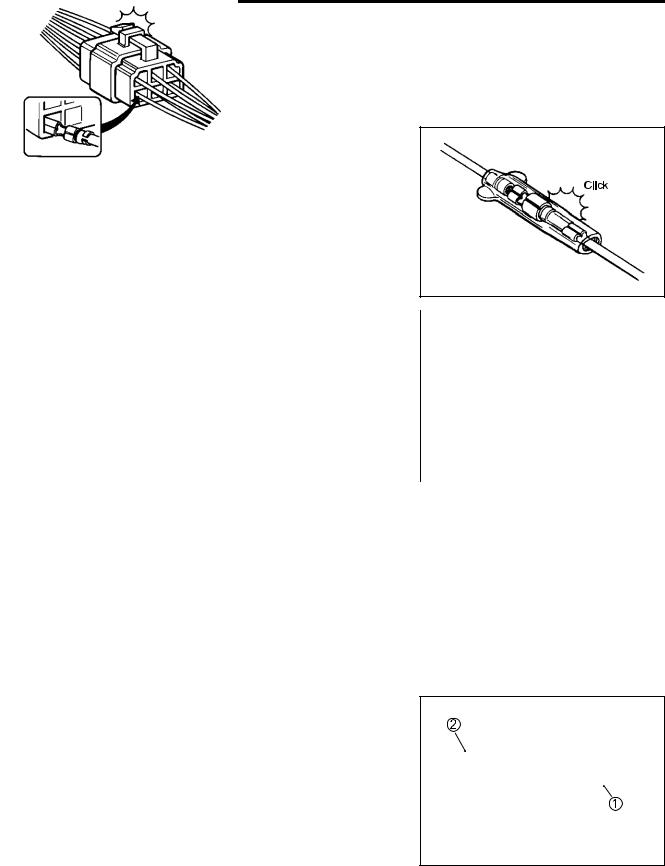
FI SYSTEM DIAGNOSIS 4-3
PRECAUTIONS IN SERVICING
When handling the component parts or servicing the FI system, observe the following points for the safety of the system.
ELECTRICAL PARTS
CONNECTOR/COUPLER
•When connecting a connector, be sure to push it in until a click is felt.
• With a lock type coupler, be sure to release the lock when dis- |
|
|
|||
connecting, and push in fully to engage the lock when con- |
|
Click |
|||
necting. |
|
|
|
|
|
• When disconnecting the coupler, be sure to hold the coupler |
|
E |
|||
body and do not pull the lead wires. |
|
L |
|||
|
|
||||
|
|
|
|
||
• Inspect each terminal on the connector/coupler for looseness |
|
||||
or bending. |
|
|
|
|
|
• Inspect each terminal for corrosion and contamination. |
|
|
|
||
The terminals must be clean and free of any foreign material |
|
||||
|
M |
|
|
|
|
|
|
|
|
||
which could impede proper terminal contact. |
P |
|
|||
• Inspect each lead wire circuit for poor connection by shaking it |
|
|
|||
by hand lightly. If any abnormal condition is found, repair or |
|
|
|||
replace. |
S |
|
|
|
|
A |
|
|
|
|
|
|
|
|
|
|
|
•When taking measurements at electrical connectors using a tester probe, be sure to insert the probe from the wire harness side (backside) of the connector/coupler.
1 Coupler
2 Probe
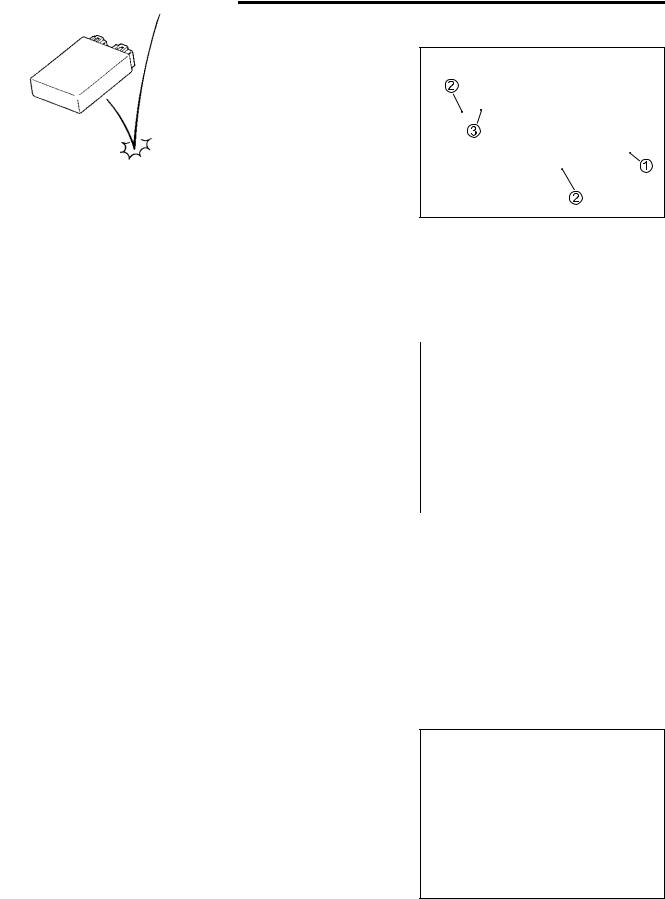
4-4 FI SYSTEM DIAGNOSIS
•When connecting meter probe from the terminal side of the coupler (where connection from harness side not being possi-
ble), use extra care not to force and cause the male terminal to bend or the female terminal to open.
Connect the probe as shown to avoid opening of female terminal.
Never push in the probe where male terminal is supposed to fit.
•Check the male connector for bend and female connector for excessive opening. Also check the coupler for locking (looseness), corrosion, dust, etc.
1 Coupler
2 Probe
3 Where male terminal fits
FUSE |
|
|
|
• When a fuse blows, always investigate the cause to correct it |
|
E |
|
and then replace the fuse. |
|
|
|
• Do not use a fuse of a different capacity. |
|
||
• Do not use wire or any other substitute for the fuse. |
|
||
|
|
L |
|
|
P |
||
|
M |
|
|
|
|
|
|
ECM/VARIOUS SEN |
A |
|
|
|
|
||
• Since each component is a high-precision part, great care |
|
INCORRECT |
|
ORS |
|
||
should be taken not to apply any sharp impacts during |
|
|
|
removal and installation. |
|
|
|
|
|
|
|
•Be careful not to touch the electrical terminals of the ECM. The static electricity from your body may damage this part.
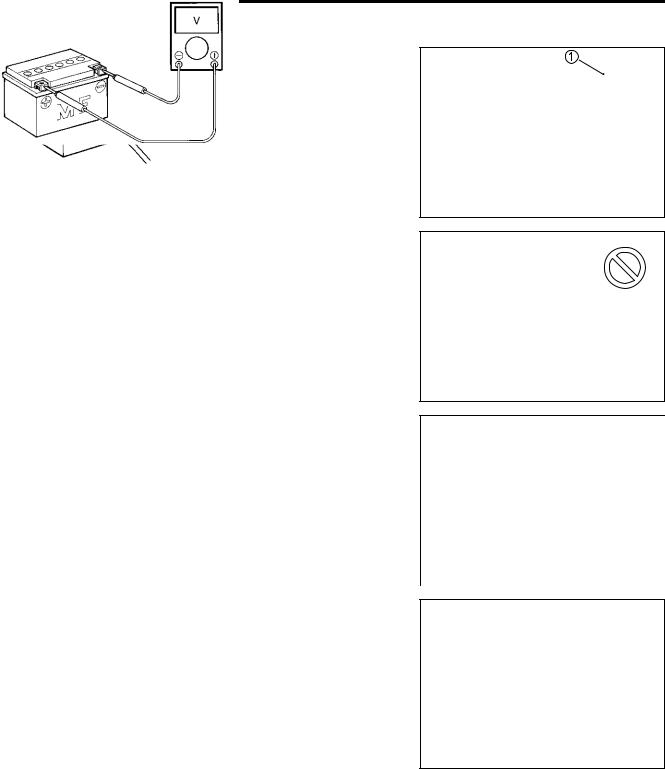
FI SYSTEM DIAGNOSIS 4-5
• When disconnecting and connecting the ECM, make sure to turn OFF the ignition switch 1, or electronic parts may get damaged.
• Battery connection in reverse polarity is strictly prohibited. |
INCORRECT |
Such a wrong connection will damage the components of the |
|
FI system instantly when reverse power is applied. |
|
|
|
E |
|
|
|
|
|
|
L |
|
|
• Removing any battery terminal of a running engine is strictly |
|
|
|
prohibited. |
P |
|
|
|
|
|
|
The moment such removal is made, damaging counter elec- |
|
|
|
tromotive force will be applied to the |
ECM |
|
|
which may result in |
|
|
|
serious damage. |
|
|
|
A |
|
|
|
S |
|
|
|
|
|
|
|
•Before measuring voltage at each terminal, check to make sure that battery voltage is 11 V or higher. Terminal voltage check with a low voltage battery will lead to erroneous diagnosis.
•Never connect any tester (voltmeter, ohmmeter, or whatever) to the ECM when its coupler is disconnected.
Otherwise, damage to ECM may result.
•Never connect an ohmmeter to the ECM with its coupler connected. If attempted, damage to ECM or sensors may result.
•Be sure to use a specified voltmeter/ohmmeter. Otherwise, accurate measurements may not be obtained and personal injury may result.
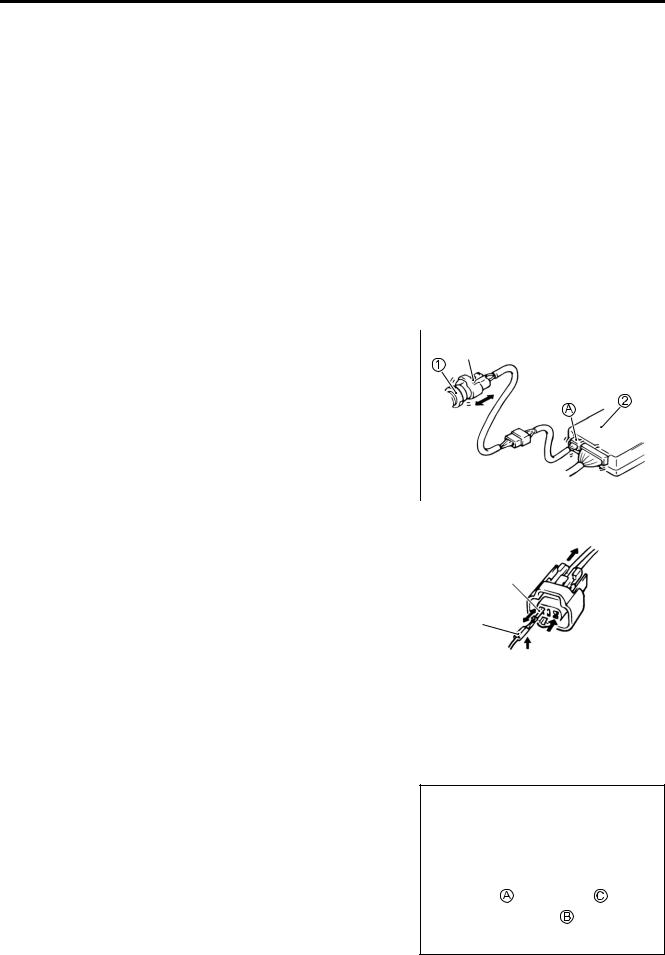
• Disconnect the negative cable from the battery. |
|
|
*1 |
• Check each connector/coupler at both ends of the circuit |
|
||
|
|
||
being checked for loose connection. Also check for condition |
|
E |
|
of the coupler lock if equipped. |
|
|
|
|
|
|
|
1 Sensor |
|
L |
|
2 ECM |
|
||
*1 Check for loose connection.P |
|||
M |
|
|
|
|
|
||
|
|
||
• Using a test male terminal, check the female terminals of the |
|
|
|
circuit being checked for contact tension. |
|
|
|
A |
(possibly |
|
|
Check each terminal visually for poor contact |
|
*1 |
|
caused by dirt, corrosion, rust, entry of foreign object, etc.). At |
|
||
|
|
||
S |
|
|
|
the same time, check to make sure that each terminal is fully |
|
|
|
inserted in the coupler and locked. |
|
|
*2 |
If contact tension is not enough, rectify the contact to increase |
|
|
|
tension or replace. |
|
|
|
The terminals must be clean and free of any foreign material |
|
|
|
which could impede proper terminal contact. |
|
|
|
|
|
|
|
*1 Check contact tension by insert- |
|
|
|
ing and removing. |
|
|
|
*2 Check each terminal for bend |
|
|
|
and proper alignment. |
|
|
|
•Using continuity inspect or voltage check procedure as described below, inspect the wire harness terminals for open circuit and poor connection. Locate abnormality, if any.
A Looseness of crimping
B Open
C Thin wire (a few strands left)
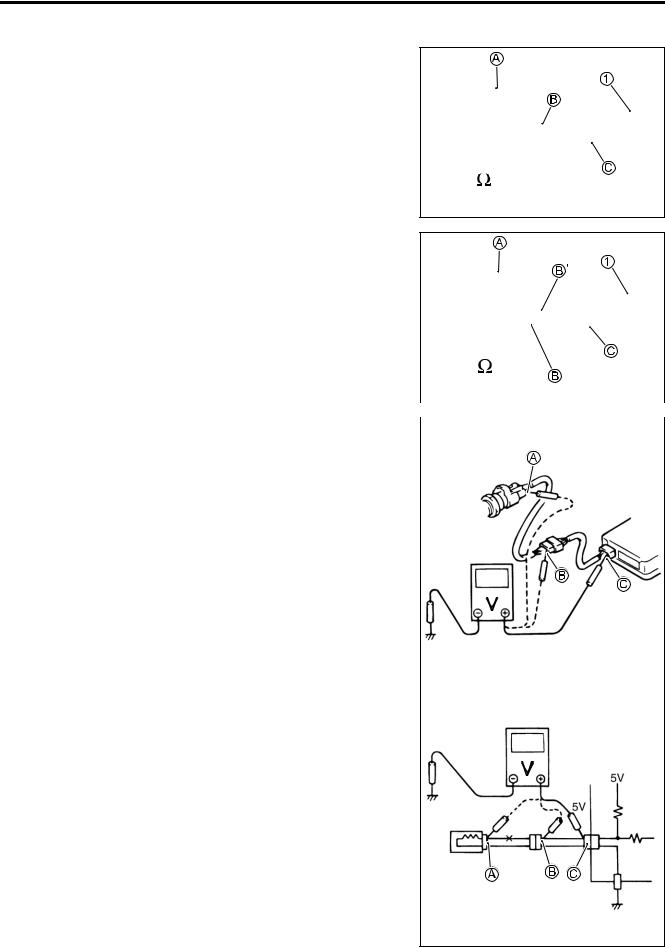
FI SYSTEM DIAGNOSIS 4-7
Continuity check
• Measure resistance across coupler B (between A and C in the figure).
If no continuity is indicated (infinity or over limit), the circuit is open between terminals A and C.
1 ECM
• Disconnect the coupler B and measure resistance between couplers A and B.
If no continuity is indicated, the circuit is open between couplers A and B. If continuity is indicated, there is an open circuit between couplers B’ and C or an abnormality in coupler B’ or coupler C.
|
|
|
|
|
|
|
|
|
1 ECM |
E |
|
|
|||
|
|
|
|
|
|
|
|
|
|
|
|
|
|||
VOLTAGE CHECK |
L |
|
|
||||
|
P |
|
|
|
|
|
|
If voltage is supplied to the circuit being checked, voltage check |
|
|
|
|
|
|
|
can be used as circuit check. |
M |
|
|
|
|
|
|
|
|
|
|
|
|
|
|
• With all connectors/couplers connected and voltage applied |
|
|
|
|
|
|
|
to the circuit being checked, measure voltage between each |
|
|
|
|
|
|
|
terminal and body ground. |
A |
|
|
|
|
|
|
|
|
|
|
|
|
|
|
S |
|
|
|
|
|
|
|
If measurements were taken as shown in the figure at the right |
|
|
|
|
|
|
|
and results are as listed below, it means that the circuit is open |
|
|
|
|
|
|
|
|
|
|
|
|
|
||
between terminals A and B. |
|
|
|
|
|
|
|
Voltage Between: |
|
|
|
|
|
|
|
C and body ground: Approx. 5 V |
|
|
|
|
|
|
|
B and body ground: Approx. 5 V |
|
|
|
|
|
|
|
A and body ground: |
0 V |
|
|
|
|
|
|
|
|
|
|
|
|
|
|
|
|
|
|
Also, if measured values are as listed |
below, a resistance |
|
|
|
|
|
|
5 V |
|||
|
|
|
|
|
|
||||||
|
|
|
|
|
|
|
|||||
(abnormality) exists which causes the voltage drop in the circuit |
|
|
|
|
|
|
|
||||
|
|
|
|
5 V |
|
|
|||||
between terminals A and B. |
|
|
|
|
|
|
|
|
|
||
|
|
|
|
0 V |
|
5 V |
|||||
Voltage Between: |
|
|
|
|
|
||||||
|
|
|
|
|
|
|
|||||
C and body ground: Approx. 5 V |
|
|
|
|
|
|
|
|
|
||
B and body ground: Approx. 5 V |
|
|
2 V voltage drop |
|
|
|
|
|
|
|
|
|
|
|
|
|
|
|
|
|
|||
A and body ground: |
3 V |
|
|
|
|
|
|
|
|
|
|
|
|
|
|
|
|
|
|
|
|
||
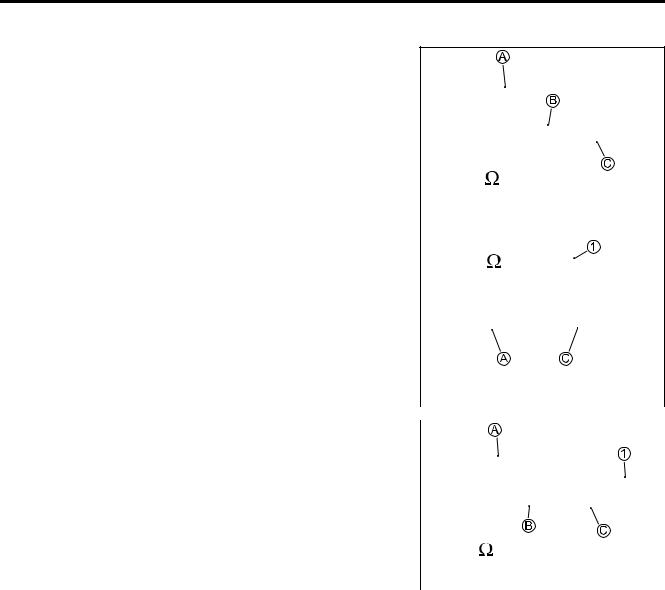
4-8 FI SYSTEM DIAGNOSIS
SHORT CIRCUIT CHECK (WIRE HARNESS TO GROUND) |
|
• Disconnect the negative cable from the battery. |
|
• Disconnect the connectors/couplers at both ends of the circuit |
*1 |
to be checked. |
|
NOTE:
If the circuit to be checked branches to other parts as shown, disconnect all connectors/couplers of those parts. Otherwise, diagnosis will be misled.
• Measure resistance between terminal at one end of circuit (A terminal in figure) and body ground. If continuity is indicated, there is a short circuit to ground between terminals A and C.
5 V
|
|
1 Other parts |
|
|
|
|
|
|
|
*1 To other parts |
|
|
|
|
|
|
|
|
|
|
|
|
|
|
|
|
|
|
|
||
• Disconnect the connector/coupler included in circuit (coupler |
L |
|
|||||
|
E |
|
|||||
B) and measure resistance between terminal A and body |
|
|
|
|
*1 |
||
ground. |
|
|
|
|
|
|
|
|
M |
|
|
|
|
|
|
|
|
|
|
|
|
|
|
If continuity is indicated, the circuit is shorted to thePground |
|
||||||
between terminals A and B. |
A |
|
|
|
|
|
|
|
|
|
|
|
|
||
|
|
|
|
|
|
||
|
|
|
|
|
|
||
S |
1 ECM |
|
|
|
|
|
|
|
|
|
|
|
|
|
|
|
|
*1 To other parts |
|
|
|
|
|
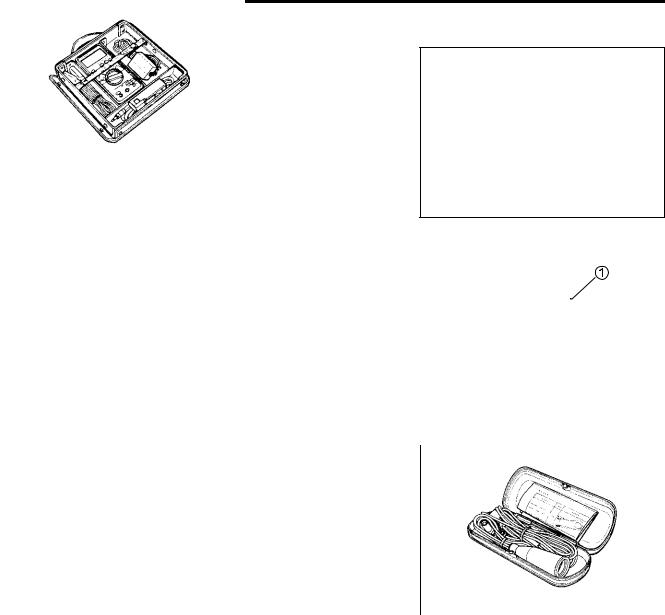
FI SYSTEM DIAGNOSIS 4-9
USING THE MULTI-CIRCUIT TESTER
•Use the Suzuki multi-circuit tester set (09900-25008).
•Use well-charged batteries in the tester.
•Be sure to set the tester to the correct testing range.
USING THE TESTER |
|
|
|
• Incorrectly connecting the + and - probes may cause the |
|
||
inside of the tester to burnout. |
|
|
|
• If the voltage and current are not known, make measure- |
|
||
ments using the highest range. |
|
|
|
• When measuring the resistance with the multi-circuit tester 1, |
|
||
∞ will be shown as 10.00 MΩ and “1” flashes in the display. |
|
||
• Check that no voltage is applied before making the measure- |
|
||
ment. If voltage is applied the tester may be damaged. |
|
|
|
• After using the tester, turn the power off. |
|
|
|
|
E |
||
09900-25008: Multi-circuit tester set |
|
||
|
P |
|
|
NOTE: |
|
L |
|
* When connecting the multi-circuit tester, use the needle |
|||
M |
|
|
|
pointed probe to the back side of the lead wire coupler and |
|||
connect the probes of tester to them. |
|
|
|
A |
|
|
|
* Use the needle pointed probe to prevent the rubber of the |
|||
S |
|
|
|
water proof coupler from damage. |
|
|
|
09900-25009: Needle pointed probe set |
|
|
|
|
|
|
|
